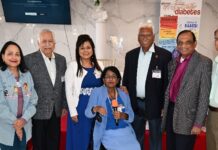 NEW BRUNSWICK, NJ: Five Rutgers professors are among 702 scholars that the American Association for the Advancement of Science (AAAS) has elevated to the rank of fellow. The pre-eminent national scientific organization selects fellows based on their efforts in advancing science or fostering applications considered scientifically or socially distinguished.
NEW BRUNSWICK, NJ: Five Rutgers professors are among 702 scholars that the American Association for the Advancement of Science (AAAS) has elevated to the rank of fellow. The pre-eminent national scientific organization selects fellows based on their efforts in advancing science or fostering applications considered scientifically or socially distinguished.
Joining 52 previous Rutgers fellows, the new inductees will receive an official certificate and a gold and blue rosette pin Saturday, Feb. 16, at the AAAS Fellows Forum during the 2013 AAAS Annual Meeting in Boston, Mass.
The new Rutgers AAAS fellows are:
Monica Driscoll, Department of Molecular Biology and Biochemistry, School of Arts and Sciences. Driscoll investigates the fundamental biology of aging and the neurodegenerative process. She focuses on mechanisms that can protect against catastrophic neuronal loss occurring as a result of nerve cell injury, neurodegenerative diseases like Parkinson’s and Alzheimer’s, or the age-related decline of cell and tissue systems. Driscoll and her team are known as leaders in the field of healthspan genetics, a new area of science focused on determining strategies for prolonging efficient youthful-like functions and creating a higher quality of life for a longer period of time.
The association cited Driscoll “for pioneering research in developmental neurogenics, molecular mechanisms of aging and the molecular genetics of neuronal cell death.”
Prof. Driscoll lives in Highland Park.
 Yogesh Jaluria, Department of Mechanical and Aerospace Engineering, School of Engineering. Jaluria is a leading authority in thermal science and engineering, and has been recognized for contributions to fundamental and applied knowledge of heat transfer and fluid mechanics. He is particularly recognized for work on buoyancy-induced flows, such as the way warm water or air create currents as they rise in a body of water or the atmosphere. These principles have been useful in understanding environmental phenomena and the spread and growth of fires in enclosed spaces, in particular heat transport through elevator shafts in high rise buildings. Jaluria has also made contributions to materials processing, including thermal processing of polymers, fabricating thin films and optical fiber drawing.
Yogesh Jaluria, Department of Mechanical and Aerospace Engineering, School of Engineering. Jaluria is a leading authority in thermal science and engineering, and has been recognized for contributions to fundamental and applied knowledge of heat transfer and fluid mechanics. He is particularly recognized for work on buoyancy-induced flows, such as the way warm water or air create currents as they rise in a body of water or the atmosphere. These principles have been useful in understanding environmental phenomena and the spread and growth of fires in enclosed spaces, in particular heat transport through elevator shafts in high rise buildings. Jaluria has also made contributions to materials processing, including thermal processing of polymers, fabricating thin films and optical fiber drawing.
The association cited Jaluria “for outstanding pioneering contributions to the field of thermal science and engineering, particularly to materials processing, buoyancy-induced flows, fire spread, energy storage and environmental flows.”
Prof. Jaluria lives in Monroe Township
 Jing Li, Department of Chemistry and Chemical Biology, School of Arts and Sciences. Li researches materials that are potentially useful for clean and renewable energy applications, including solar electricity production, efficient solid-state lighting, and capturing harmful gases from burning fossil fuel and converting them back to fuel or into other useful materials. Her work focuses on understanding the chemistry of new inorganic materials and inorganic-organic hybrid materials, including their design, synthesis and modification. She and her colleagues have discovered a nanostructured semiconductor material family that may one day become a viable substitute for materials made with rare earth elements, which are in high demand and short supply.
Jing Li, Department of Chemistry and Chemical Biology, School of Arts and Sciences. Li researches materials that are potentially useful for clean and renewable energy applications, including solar electricity production, efficient solid-state lighting, and capturing harmful gases from burning fossil fuel and converting them back to fuel or into other useful materials. Her work focuses on understanding the chemistry of new inorganic materials and inorganic-organic hybrid materials, including their design, synthesis and modification. She and her colleagues have discovered a nanostructured semiconductor material family that may one day become a viable substitute for materials made with rare earth elements, which are in high demand and short supply.
The association cited Li “for contributions and innovative research in the development and applications of multifunctional materials, particularly inorganic-organic hybrid semiconductors and microporous metal organic framework compounds.”
Prof. Li lives in Cranbury
 Manish Parashar, Department of Electrical and Computer Engineering, School of Engineering. Parashar has made pioneering contributions to high-performance computing, specifically in parallel and distributed systems that run massive processing tasks on multiple computers. His work has been applied to several scientific and engineering fields, including seismic modeling, combustion, biomedical informatics, oceanography, astrophysics and plasma physics. He has demonstrated expertise in data structures and algorithms, runtime management and optimization, and programming abstraction and software infrastructures.
Manish Parashar, Department of Electrical and Computer Engineering, School of Engineering. Parashar has made pioneering contributions to high-performance computing, specifically in parallel and distributed systems that run massive processing tasks on multiple computers. His work has been applied to several scientific and engineering fields, including seismic modeling, combustion, biomedical informatics, oceanography, astrophysics and plasma physics. He has demonstrated expertise in data structures and algorithms, runtime management and optimization, and programming abstraction and software infrastructures.
The association cited Parashar “for distinguished contributions to high-performance parallel and distributed computing and its application to the advancement of computational science and engineering.”
Prof. Parashar lives in Monmouth Junction
 Mark Gregory Robson, dean of agricultural and urban programs in the School of Environmental and Biological Sciences, and professor and extension specialist in entomology. Robson’s research has focused on the interaction of human beings and pesticides, especially in developing countries. He examines policies that affect pesticide use on a global scale and studies the risk assessment process as it relates public health and health policy. He grew up on a farm in Burlington County, New Jersey, and is charged with updating the agricultural sciences major at Rutgers, and recruiting new students to the major.
Mark Gregory Robson, dean of agricultural and urban programs in the School of Environmental and Biological Sciences, and professor and extension specialist in entomology. Robson’s research has focused on the interaction of human beings and pesticides, especially in developing countries. He examines policies that affect pesticide use on a global scale and studies the risk assessment process as it relates public health and health policy. He grew up on a farm in Burlington County, New Jersey, and is charged with updating the agricultural sciences major at Rutgers, and recruiting new students to the major.
The association cited Robson “for an illustrious career in exposure science that has changed agricultural practices and pesticide regulation while simultaneously educating students, the public and policy-makers.”
Prof. Robson lives in Jacobstown
About the AAAS
Founded in 1848, the AAAS is the world’s largest general scientific society and works to advance science for human well-being through its projects, programs and publications. The tradition of selecting AAAS fellows began in 1874.
AAAS includes 261 affiliated societies and academies of science, serving 10 million individuals. The association conducts many programs in the areas of science policy, science education and international scientific cooperation. Its prestigious peer reviewed journal Science has the largest paid circulation of any peer-reviewed general science journal in the world, with an estimated readership of 1 million.
India Post News Service






